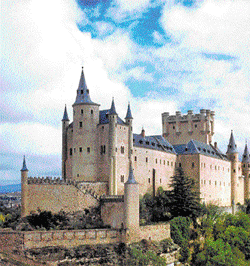
Preeti Verma Lal visits Segovia, a UNESCO World Heritage City teeming with stone-built monuments and cobblestone alleys thathave a story or two to tell.
The throne clad in red velvet was magnificent, the embroidered eagle stared menacingly, and the dome embellished in geometric motifs surreal.
Mariano Vela Bautista, the dapper guide with a salt-and-pepper beard, doffed his fedora and stood still in Segovia Alcazar’s Throne Room. “This is where Christopher Columbus stood when Queen Isabella gambled on his proposal for a western route to China, a voyage that would lead to the discovery of America.” I looked at the ground
beneath my feet — I was standing on history.
Almost."That is what Segovia is all about. History,” Bautista began his story about Segovia, a UNESCO World Heritage City which sits coquettishly close to Madrid, Spain’s capital. It is replete with twisted alleys, Romanesque structures, and legends that could tire any storyteller.
“Look at the Alcazar, doesn’t it resemble the Sleeping Beauty castle?” I thought Bautista’s funny bone had inflated.
Segovia and Disneyland? Until I turned my head around the ridge and looked askance at the castle that rises out of a rocky crag. He was right. The Alcazar does closely resemble the Sleeping Beauty Castle — its sharp slate spires almost reaching out to the sapphire sky.
That, however, was just the beginning of Segovia, the medieval city, which was once populated by the Celtiberians and, of course, the Romans. Within the provincial capital stands the Segovia Mint, which is touted as the oldest industrial building still standing in Spain and one of the oldest mechanised manufacturing plants still remaining in the world.
The Cathedral dedicated to Virgin Mary had a spire built of American mahogany and was the tallest tower in Spain. The mahogany spire was destroyed in a fire caused by thunderstorm and replaced by a stone spire.
Architectural marvel
Walking on Segovia’s cobbled pathway, my jaws had dropped. The city seems so dignified, so mighty, yet so austere in its antiquity.
I was soaking in the Segovian sun till Bautista threw in a ghost. And a petite girl got so tired of fetching water that she sold her soul to the ghost who built her the aqueduct, which finds mention in the Heritage Site credential along with the city of Segovia.
“The ghost must have been a master architect,” I threw in banter. Well, the ghost is pure baloney. The Segovian aqueduct which is one of the best-preserved testimony to Roman engineering and one of the most significant monuments in the Iberian Peninsula, was built by the Romans nearly 2,000 years ago.
This 894-metre-long aqueduct has 163 arches made of 20,000 uneven granite blocks which have been stacked on each other without an ounce of mortar. Incredibly, not a stone has fallen off in these 2,000 years.
So glorious was the aqueduct that it functioned till the late 1970s. Today, the aqueduct no longer brings water from the river which meanders 15 km away, but it does bring millions of tourists from across the world who gape at this feat of Roman
engineering.
In the cobblestone square by the aqueduct, children were giggling on the merry-go-round, women were hurrying home to cook meals and puppeteers were packing off after a week of frenzied puppeteering.
The sun was dipping down the rugged arches and Segovia was falling silent as the chirpy evening began melding with a serene night. My feet were sore and my eyelids were dropping with sleep.
But my tryst with Segovia and all things Segovian was not over. Not yet. “It is sacrilege to step out without digging your fork into the Segovia’s culinary claim to fame: Cochinillo asado,” Bautista proclaimed vehemently. Cochinillo asado? I — and whatever Cochinillo asado was — was getting lost in translation.
I tried hard to roll the tongue right, but when I failed miserably, Arturo Ortiz, Tourism Counsellor, Embassy of Spain, gallantly came to my rescue. “It is the famous roast suckling pig, a 21-day-old milk-fed pig that is roasted with traditional herbs in a stone oven.” 21 days? I tremored at the thought of slaughtering a 21-day-old piglet. But Segovia borrows its fame from the suckling pig.
I held my breath and stepped into Restaurant Duque that is a small walk from the Roman Aqueduct. Established in 1895, Duque is a definite haunt of foodies; it has an old-world restaurant with burly trusses, red table linen, large windows and cheery waiters. Before I could settle, a jolly Julian Duque walked in with a porcelain plate in hand. Intrigued, I waited with bated breath.
Laid on a large brown ceramic plate was a roasted pig. Duque muttered in Spanish what seemed like a requiem/prayer to the departed pig. “Now, I shall cut the pig with the plate.” Plate? Why not a knife? “In Segovia, roasted pigs are cut with porcelain plates,” Duque explained.
I closed my eyes. I could not bear the sight. Seconds later, I shuddered. The clatter of broken porcelain frightened me. Duque was following the tradition. In Segovia, after the pig is cut, the plate is smashed on the ground!
While everyone raved about the famous Segovian suckling pig, I dug my spoon into a bowl of flat pale beans, another Segovian speciality.
That one day in the World Heritage City of Segovia, I picked more history lessons than all I had learnt in high school. As I walked back towards the Roman Aqueduct, a dry petal of Californian red poppy got caught in my long hair. I brought it home. Every time I look at it, I think of that one day when Christopher Columbus stood in the red Throne Room.